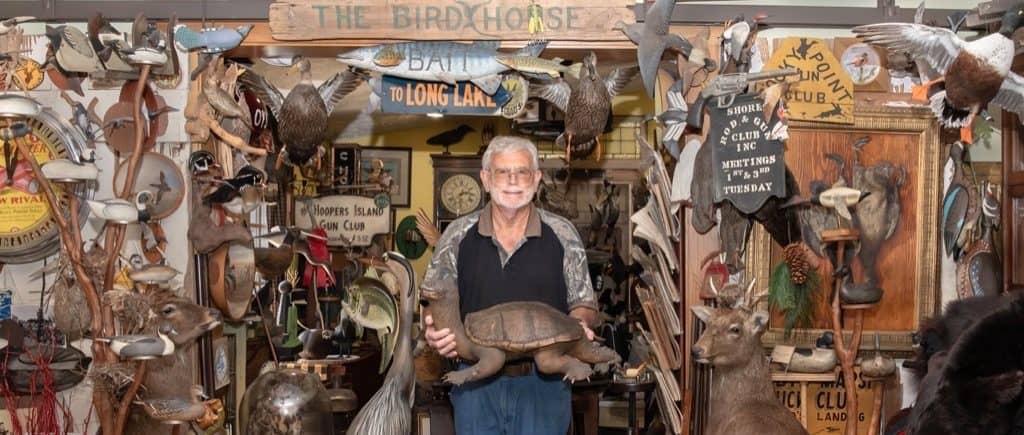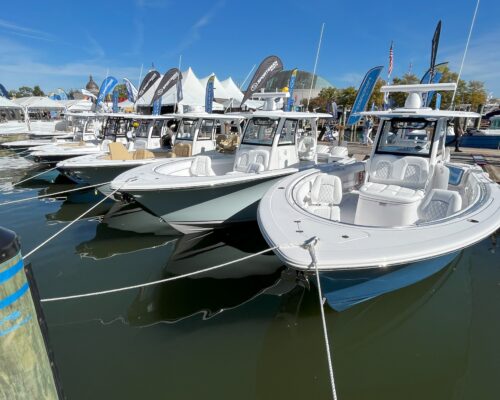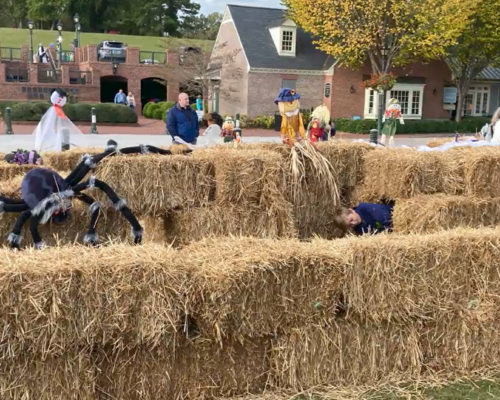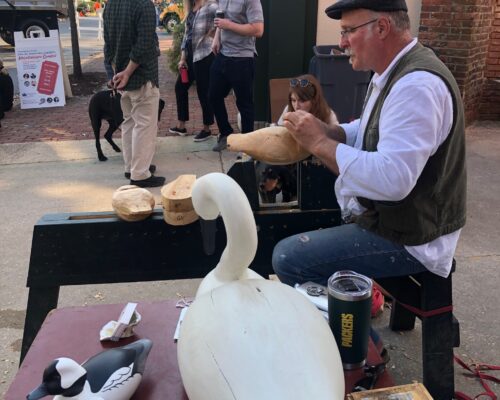Meet the Eastern Shore taxidermists who bring the dead to life
By Marty LeGrand
To visit Charlie and C.J. Fegan’s taxidermy studio in Edgewater is to wander into Mother Nature’s body shop. Wild animals in various states of repair and reassembly fill the second-floor space where father and son work.
In no particular order there are: seven mounted deer heads ready for pickup, a row of tanned fox pelts, two rare paradise shelducks from New Zealand rehydrating in the sink, an immense road-killed beaver recovering from nasal reconstruction, and a pair of canvasbacks whose formaldehyde-injected feet are push-pinned onto their permanent resting place, a faux log. The creepy, fist-sized tarantula lurking in a shadowbox is someone else’s work.
Located above the business’s showroom, the airy studio is part operating theater, part workshop, and part trophy gallery overseen by an array of vibrant, glassy-gazed spectators of the Fegans’ creation. The ambiance falls somewhere between fascinating and slightly surreal.
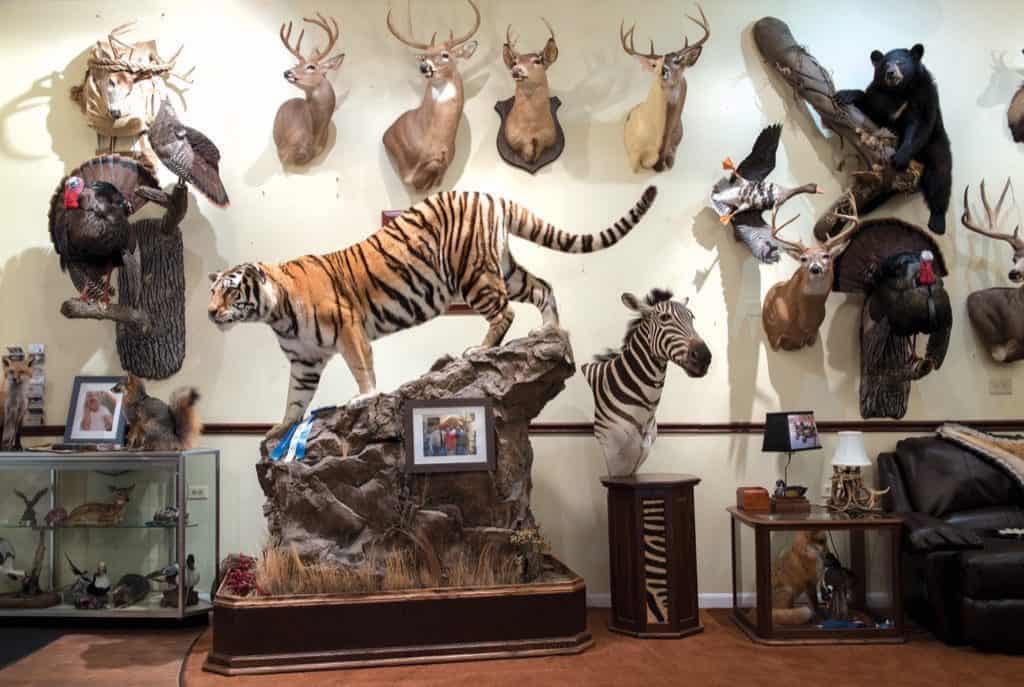
Charlie cleans a duck carcass while a nearly six-foot black bear on its hind legs looms behind him. Son C.J. smoothes a deer hide—a young hunter’s first kill—into calfskin-like suppleness, as a red fox eyes him quizzically from across the room. Two fully sentient animals, the Fegans’ playful black lab Drake and a snoozing cat, take this all in stride.
It’s mid-August. Archery deer season begins in three weeks, duck hunting in two months, and the Fegans are still working on last year’s orders, a logjam common among taxidermists. They already have a 12-month backlog of critters chilling on the premises. “We’ve got fourteen freezers and they’re all full,” Charlie says. “And we stopped taking work three or four months ago.”
Waterfowling, deer hunting, upland game bird shooting, sportfishing—they’re as indigenous to the Chesapeake as blue crabs and skipjacks. So is the practice of preserving hunting and fishing quarry for posterity.
The Fegans’ bread-and-butter are ducks (Charlie’s specialty) and deer (C.J.’s). Both animals are mainstays for the region’s hundreds of licensed commercial taxidermists. According to the Maryland Department of Natural Resources, Maryland hunters bagged more than 77,000 deer during last year’s archery, firearms, and muzzleloader seasons. The U.S. Fish & Wildlife Service, which monitors migratory bird harvests, estimated that hunters killed about 120,000 ducks and nearly 186,000 geese during the 2017-2018 season in Maryland. An unknown percentage of those become prideful décor for fireplace mantels, trophy walls, dens, and basements.
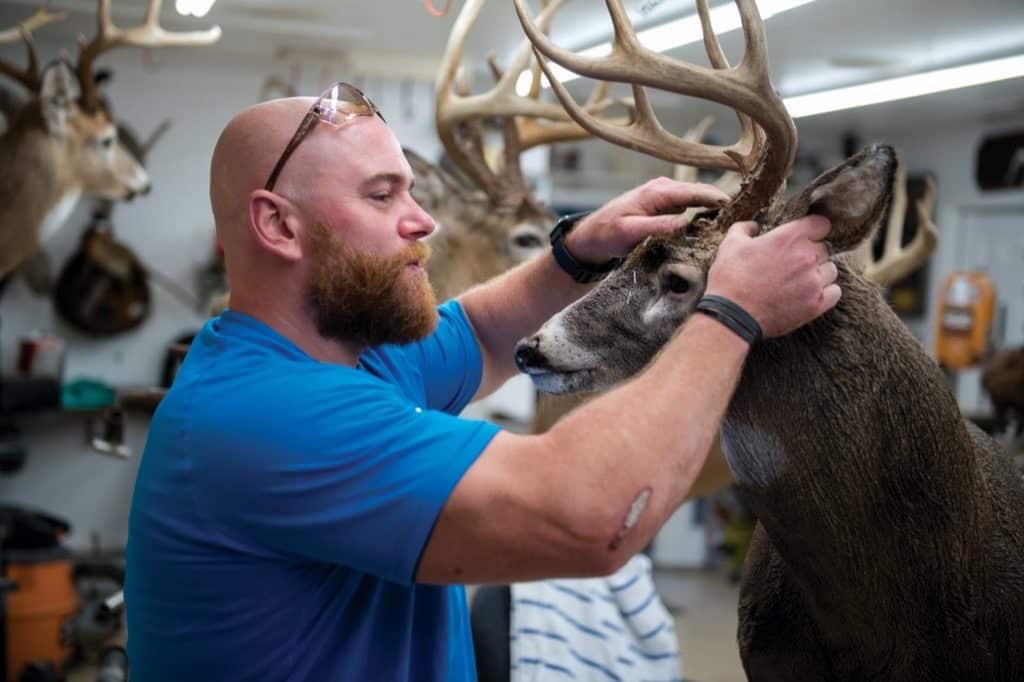
Taxidermy is an art form wrapped in a riddle: It attempts to remake the lifeless into a convincingly lifelike version of the deceased’s former self. Practitioners do so with a scarcity of original material; the animal’s skin and, at most, a few appendages like antlers are reused. The rest—the body, neck, limbs, and unrecyclable bits like eyes, ears, noses, lips, and tongues—have to be made, using either prefabricated or hand-crafted parts.
Once the major body elements have been made and assembled, the taxidermist reattaches (mounts) skin that’s been carefully cleaned, stretching it over the animal’s new artificial substructure (called a form or manikin) and then sewing it up with ordinary thread or fishing line. “Stuffing” is archaic terminology, referencing the days when taxidermists simply took a hide and smooshed it full of rags, cotton or whatever until it bore a lumpy resemblance to the animal in question.
Modern taxidermy’s artistry lies in the detailing. Bullet holes and other skin tears require careful repair. Seams must be minimized. Noses need to be textured and tails fluffed. Most of all, the animal has to look authentic. A hunter will notice if his canvasback drake has brown eyes (the female’s color) instead of red, or a deer’s ears look like they belong on a donkey. Realism is the taxidermist’s mantra.
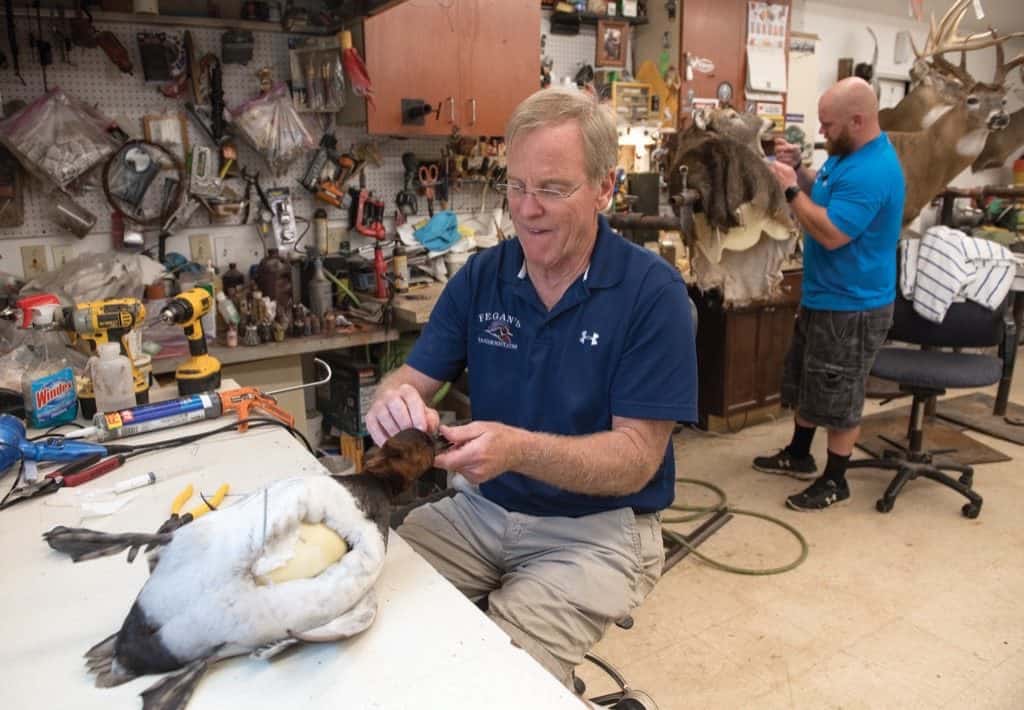
“When you start out with a duck that’s dead and, at the end of the day, it looks alive, that’s total satisfaction,” says Charlie Fegan, who’s spent 40 years in the business. “That’s what it’s all about. That’s why I do what I do.”
Taxidermy’s merits rest in the eye of the beholder. Where detractors see dead things awkwardly revived, enthusiasts see life artfully immortalized. Most taxidermists are hunters, so they’re restoring animals whose appearance, anatomy, movements, and habitat they’ve studied in the field, often since childhood.
Ronnie Newcomb, a longtime taxidermist from Dorchester County, has hunted birds since he first tagged along with his grandfather 60-plus years ago. He possesses a Wikipedic knowledge of waterfowling and taxidermy, and he collects the vintage paraphernalia of his twin passions.
“Taxidermy is pretty challenging—more than you realize—because you’ve got to put a lot of things back together somebody’s pretty much destroyed, or somewhat destroyed, because they had to be shot,” he says. “Where your real artistic work comes in is making that all come back together so it looks like it’s alive. It comes from years and years of practice and constantly studying and observing birds and waterfowl.”
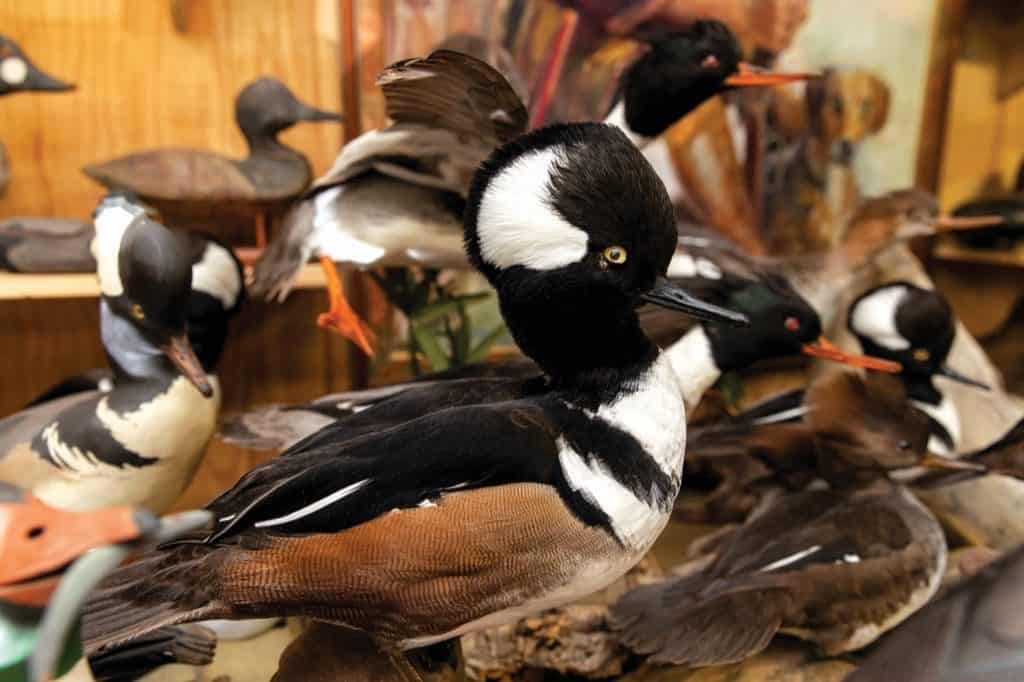
Raised in Golden Hill, Newcomb became enthralled with taxidermy for reasons that, even now, he can’t put his finger on. “Once it was in my blood, it was in my blood. I don’t know what else to say about it.”
At age nine, he began working with the late Harold Hall, an acclaimed Eastern Shore taxidermist who taught Newcomb traditional techniques he learned on Hooper’s Island from his taxidermist father. In a 1985 interview in Field & Stream, Hall compared taxidermy to watermen’s work: “You got to be born up to it to be any good.” Hall gave Newcomb a taxidermist’s upbringing. “I spent all the time I could with Mister Hall. He was almost like a father to me.”
Under his tutelage, Newcomb worked his way through various skill sets: making plaster of paris molds for heads; skinning deer hooves for novelty gun racks and table lamps; stuffing snapping turtles and big-bellied frogs; and finally mounting waterfowl and, before they were legally protected, hawks and owls.
“You learn it that way, little by little, instead of taking a crash course and thinking you’re a taxidermist,” he says. “It doesn’t work that way.” Although he never tried to make a living mounting birds (he was a lineman for Delmarva Power until retirement), Newcomb’s impeccably restored waterfowl grace private homes, hunting lodges, and nature centers.
Like Newcomb, Charlie Fegan is a lifelong waterfowl and deer hunter who took up taxidermy early. Having worked as a teenager with his waterman father, he gave up commercial fishing and the chance for a college degree to learn the trade from a man who suffered novices grudgingly. “The first day he made me work outside in the snow on a rotten goat,” Charlie recalls. After three salary-free months, he was hired. He eventually inherited his boss’s clients, mounted his first deer head in his mother’s kitchen, grew the business and acquired a partner 10 years ago when C.J. (Charlie Jr.) joined him. Between them, they’ve won a slew of awards, including three world championships.
With Charlie already an accomplished duck man, C.J. opted for deer and large mammals. “I mounted a deer and then I mounted a raccoon and then I mounted my buddy’s deer,” he says. “Once I got ate up with it, I was ate up with it. Before you know it, I’m mounting tigers.” In 2003, C.J. appeared on the nationally televised AMC series “Immortalized,” a taxidermy smackdown in which he won his match with a purgatory-esque, multi-animal mount called “Judgment Day.”
Young taxidermists like C.J. are nudging the envelope of a craft that dates to the 18th century. According to the word’s Greek derivation, taxidermists are “arrangers of skin.” Their early efforts—unnatural, stuffed pieces—fell considerably short of today’s realistic mounts. As naturalists collected field specimens for museums in the 1800s and taxidermy dioramas became chic Victorian decor, the practice evolved. American Carl Akeley ushered in the age of similitude by creating sculpted molds to produce anatomically accurate specimens for New York’s American Museum of Natural History in the early 1900s.
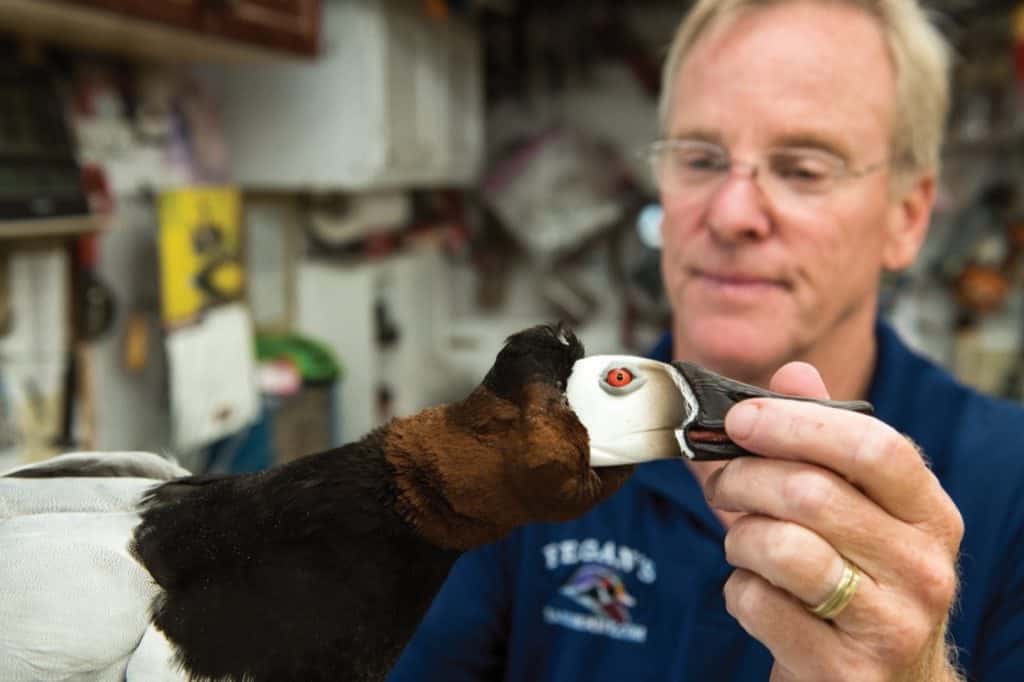
Modern taxidermy has replaced Akeley’s plaster-of-paris and papier-mâché molds with professionally sculpted, prefabricated forms (whole-body or component parts) made of lightweight polyurethane foam. Supply catalogs offer a staggering selection of bodies, anatomical accessories (eyes, noses, ears) and even prefab habitat. Need a life-size gray fox form? One popular catalog carries three-dozen poses, including sitting, standing, running, pouncing, walking uphill, even scratching an ear. Want a realistic setting for your fox? You can order a nice faux woodland branch or rock-and-stump base.
Newcomb still uses the old-school methods he was taught, building his forms essentially from scratch. He makes his bird bodies out of wood wool, finely shredded slivers of wood called excelsior, more often used as packing material and erosion control mats. Working with his hands, he shapes a duck out of wood wool and then wraps his creation—mummy-like—over and over with string to hold
it together.
“You have to keep wrapping it and get it nice and tight,” he says. “Once you get this form done, you have to put a wire in through the body and make the neck for it,” again using wood wool and string. When he’s ready to mount the duck or goose, he reuses nature-made parts. “I use the whole bird—legs, the bill, the skull—all that has to be cleaned and put back into place,” he says.
By using prefab forms, taxidermists can invest their time perfecting a mount to accommodate clients’ growing demand for realistic, frozen-in-motion poses. When no suitably posed forms exist, they modify stock or pour new molds, either of which can add days to a project. Take the Fegans’ standing bear mount. Charlie and C.J. spent weeks cutting and repositioning—extending the torso, moving one shoulder, turning a wrist—so the bear hugs a tree trunk. Custom work comes at a price, Charlie says. “It’s $3,500 for the bear and an extra $1,000 for the alterations, and then a mouth open is $250.”
The bear grips a rigid foam tree whose texture and color can pass for real wood. Prefab bases not only lessen a taxidermist’s workload, they’re also lightweight, durable and don’t harbor bugs, the scourge of taxidermy.
“Bugs are bad business,” Charlie says. “That’s the worst thing in the world you can have in our business.” Enemy number one is the dermisted beetle (a.k.a. skin beetle), a common household pest whose extended family members devour everything from animal hides to carpet fibers to the feathers on Uncle Roy’s shoddily mounted wild turkey.
Bug prevention begins with a thorough cleaning of the skin and feathers to remove blood and body oils (the Fegans use Dawn detergent and Snuggle fabric softener). It ramps up at the “fleshing” stage, when taxidermists use knives, scalpels, scissors, and a soft-bristled, motorized grinding brush to remove every speck of meat and fat from the mount’s skin. Allow bugs to take up residence in, for example, feather tracts—the dimpled area of the skin where feathers grow—and they’ll nibble away until the wing eventually falls apart. Dermisted deterrence is the reason most taxidermists don’t use real skulls—too hard to remove meat from their tiny crevices. “I’ve seen million-dollar game rooms that are three-quarters destroyed by these bugs,” Charlie says of skin beetles.
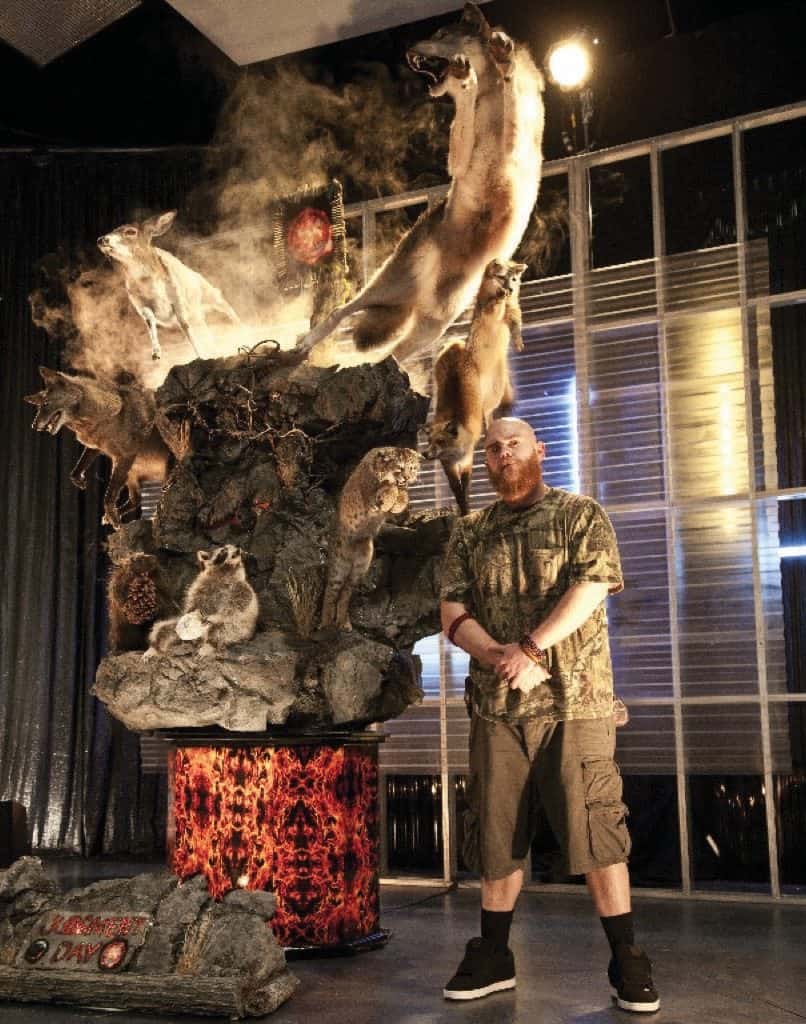
Fish taxidermy—at least the modern, prevalent version—doesn’t bother about bugs because most mounts are replicas, detailed fiberglass recreations of the fish from jaw to tailfin. Old-style fish taxidermy (called skin mounts) preserves the fish’s exterior, but its natural colors disappear when the skin dries. Taxidermists must then reapply them to the fish’s inherently greasy, hard-to-paint canvas.
Taxidermist Bruce Foster is a former charterboat captain who’s guided the likes of then-president George H.W. Bush. When he mounts a trophy fish these days, he uses only fiberglass. “I didn’t like seeing all these big fish killed, so I stopped doing skin mounts and started molding the fish,” he says. Fish taxidermists coat the original specimen—say a striped bass or a marlin—in fiberglass resin to make a two-piece, reusable mold. “What you pop out is the exact replica of that fish in fiberglass,” Foster says. “Once I built up a collection of molds, I could reproduce hundreds of fish so people didn’t have to kill them.” Customers supply their fish’s measurements and he selects a mold to match its size and desired swimming direction.
Each fiberglass replica has to be hand-painted to capture every color and shimmer on the fish, including nuanced hues like the silvery iridescence of a rockfish’s underbelly. “That’s why a lot of people don’t get into fish,” Foster says. “I was a flat artist, so color and painting came natural to me.” He improvises where necessary. “I use a lot of women’s makeup. The rosy, cheek-color stuff is perfect to put over fleshy areas around a fish’s mouth. It enhances the paint and gives it depth.”
At his studio on Kent Island, Foster also mounts ducks, geese, deer, and exotic game animals. (He was working on a life-sized musk ox last fall.) Just don’t call him a wildlife artist. “Just because you’re working with dead animals doesn’t make you an artist,” he says. “I’m not trying to re-create God’s work. I’m doing my job to the best of my ability, trying to make one singular piece—a bird, a fish, whatever—to please a customer and make the animal look as good as possible.”
Paul Rhymer, former staff taxidermist for the Smithsonian Institution, transitioned from taxidermy to wildlife sculpture for a living, but he sees the two as intertwined. “I like to continue doing taxidermy because, as a wildlife sculptor, I like having my hands in animals all the time.” When he sculpts a bobcat or casts a wild turkey in bronze at his studio near Frederick, Md., “It just reminds me of what I’m doing.”
Rhymer’s father and grandfather were Smithsonian taxidermists, and Paul presided over one of the institution’s last major taxidermy projects, the mounting of 274 animals for the Museum of Natural History’s Mammal Hall, which opened in 2003. Seven years later, he retired as the Smithsonian’s last official taxidermist. He still does contract work, often partnering with a friend on repair jobs like re-waxing the skin on the Natural History Museum’s famous elephant and restoring Stonewall Jackson’s stuffed steed Little Sorrel for the Virginia Military Institute.
Museum taxidermy is waning, Rhymer says, but overall, he sees the trade thriving. “Commercial taxidermy for sportsmen has gotten so good and so sophisticated. In the old days, the best taxidermists were museum taxidermists. The best taxidermists are doing commercial work now.” And the very best commercial work, he says, is not just technically accurate, but artful too. “At lot of taxidermists are so keyed in on symmetry because they’re trying to make [the mount] technically and anatomically correct. They let that stuff overwhelm and kill the naturalness of a piece. Where’s that little expression that gives you the sense that there’s a bit of life there? Where’s the imbalance that gives you the feel of motion?”
Expression and motion surround a visitor in the Fegans’ first-floor showroom, where a Kodiak bear balances on the balls of its hind feet and the animals in C.J.’s apocalyptic “Judgment Day” flee in palpable fear. The room’s most tranquil mount is an elegant mute swan. It swims in a Plexiglas shell by the door, awaiting a special calling only a taxidermist could conjure.
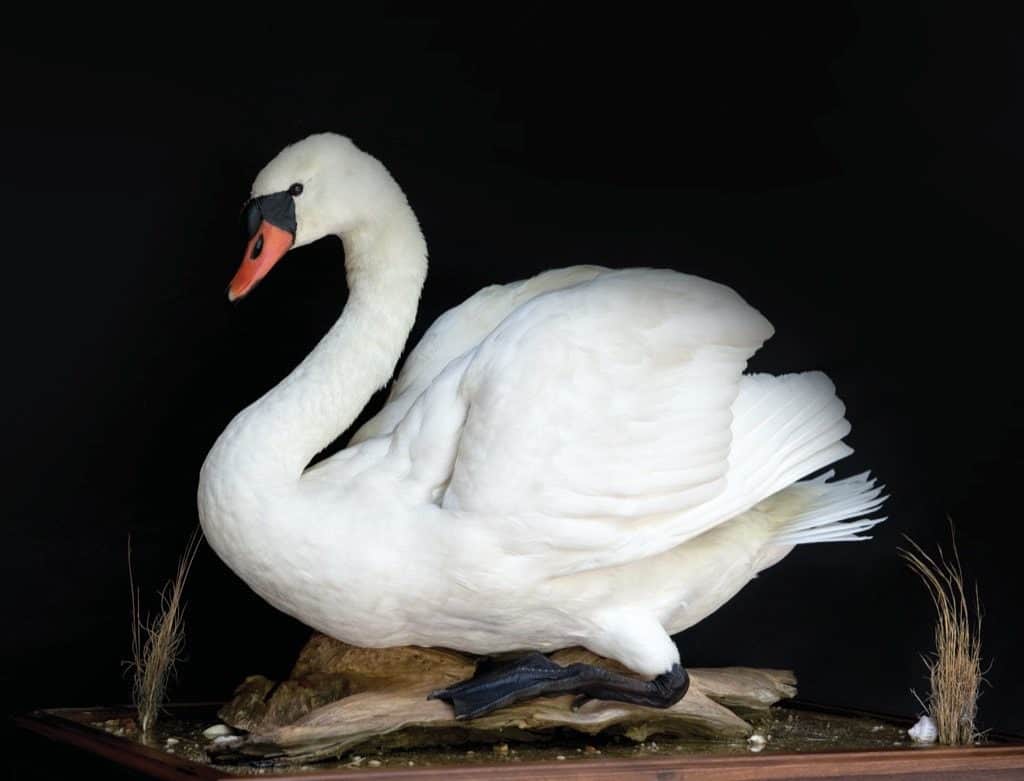
“That’s the swan my ashes are going to go in,” Charlie says, as if deceased waterfowl were a perfectly ordinary eternal resting place. He wants half his remains scattered on South River, where he fished with his father, and the other half stored in the bird, which will be installed in the Fegan family home. He’s named his creation for its purpose and, in a way, his profession: “Swan Song.”

